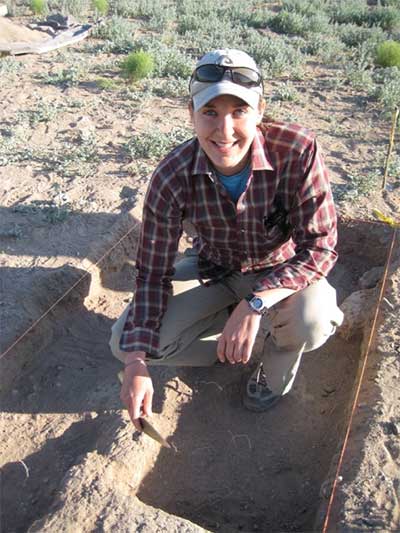“I have many more to goals to work towards,” said Dr. Putsavage.
Before joining the Greyhound family, she taught at the University of Colorado while working on her Ph.D.
Dr. Putsavage also worked at the Smithsonian’s National Museum of the American Indian for a few years after completing college.

She said that the students and faculty at ENMU are wonderful people and that she is excited about joining the community. Dr. Putsavage originally got into anthropology because of a road trip she took with her parents when she was 10. They drove from Philadelphia to San Francisco and back.
The National Parks in the west are what inspired her and “the trip to Mesa Verde was epically interesting. At that time, the park guide said archaeologists did not know what happened to the people who lived in Mesa Verde. I wanted to know where they went! People don’t just disappear.”
She later found out that archaeologists and Native groups did know what happened.
“The modern Pueblo tribes are the descendants of the people from Mesa Verde. Understanding how and why people migrated from the Mesa Verde area has taught us a lot about the past and present, drought, and what happens to social connections when the environment is under stress. It is all related,” said Dr. Putsavage.
She focuses on the ceramics made by Prehispanic peoples of the Southwest.
“Pottery can tell you a lot about people living long ago. Sometimes, you can even see the fingerprints of the people who made the pottery. It makes me feel connected to the past and reminds me that understanding our past is important for appreciating the present,” explained Dr. Putsavage.
She has come across many interesting artifacts, but one of her favorites is a 2,000-year-old cotton blanket.
Dr. Putsavage is currently investigating some of the pottery at ENMU and trying to track changes in social connections of people who lived between A.D. 1150 and 1450.
“People have always had social networks and pottery can help us to see those networks,” said Dr. Putsavage.
One of her favorite aspects about teaching is being able to share her excitement about anthropology and archaeology. She said the fields are important because they help us understand the differences in every culture and allow for respect and appreciation of other cultures.
“I have several mentors and am lucky for it. Dr. Linda Cordell always pushed me to work hard and Dr. Suzanne Eckert continues to give me advice on how to navigate my new job and being a woman in academia. They were/are both great mentors, researchers, teachers and friends,” said Dr. Putsavage.
Her parents were elementary school teachers for 35 years and loved to travel, cook and explore the world around them. They inspired her to never stop learning.
“My partner, Tim Campbell, is a Ph.D. student at Texas A&M and is in South Africa this semester finishing up his dissertation research. Tim and I have three cats, Polly, Snarf and Blue, who are also important members of my family,” said Dr. Putsavage.
She grew up in Bucks County, Pennsylvania, outside of Philadelphia.
“This is close to where George Washington crossed the Delaware River during the Revolutionary War. It is hot and humid in the summer. I moved out west to Boulder, Colorado, in 2005 and like the open vistas of the west,” said Dr. Putsavage


